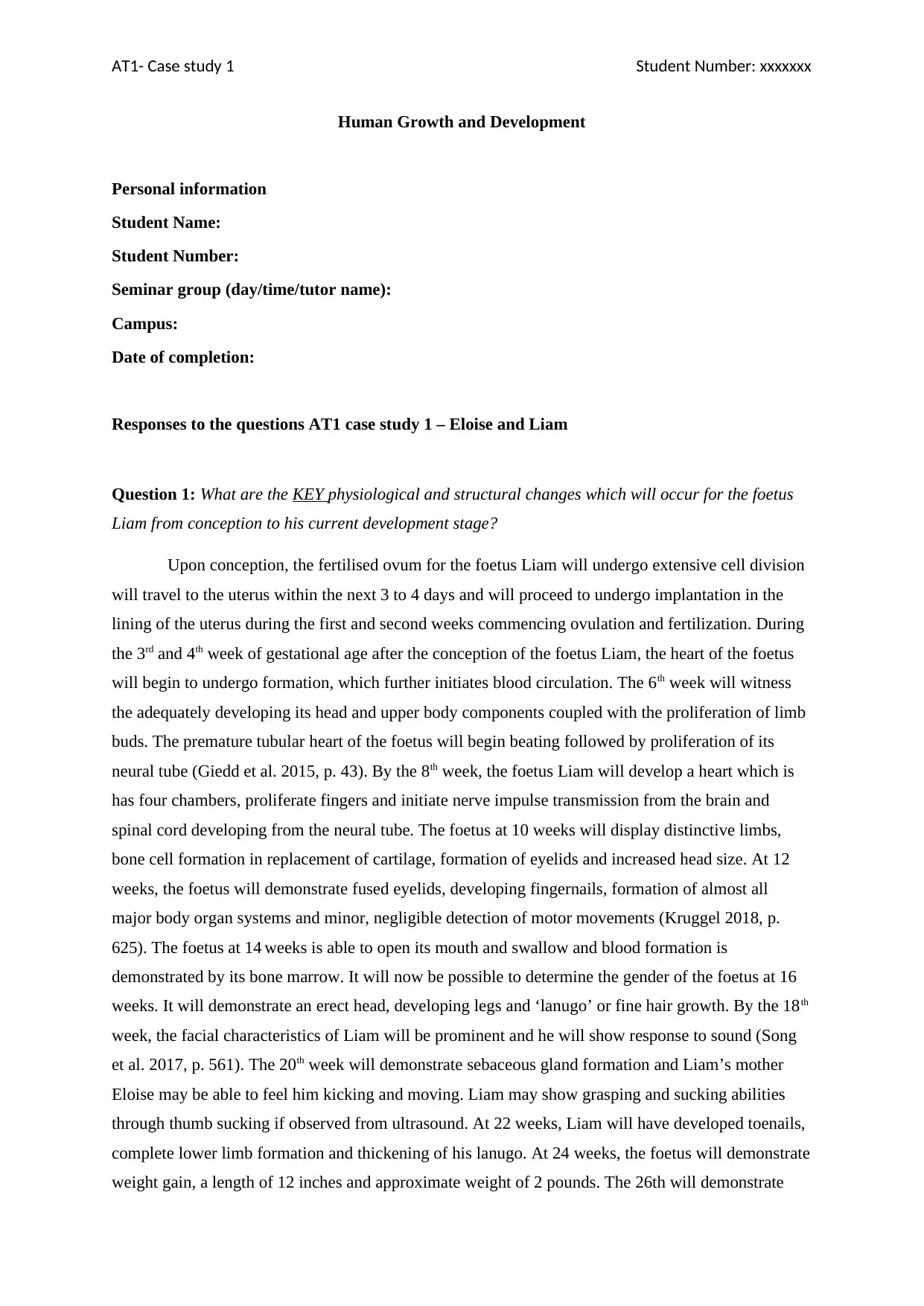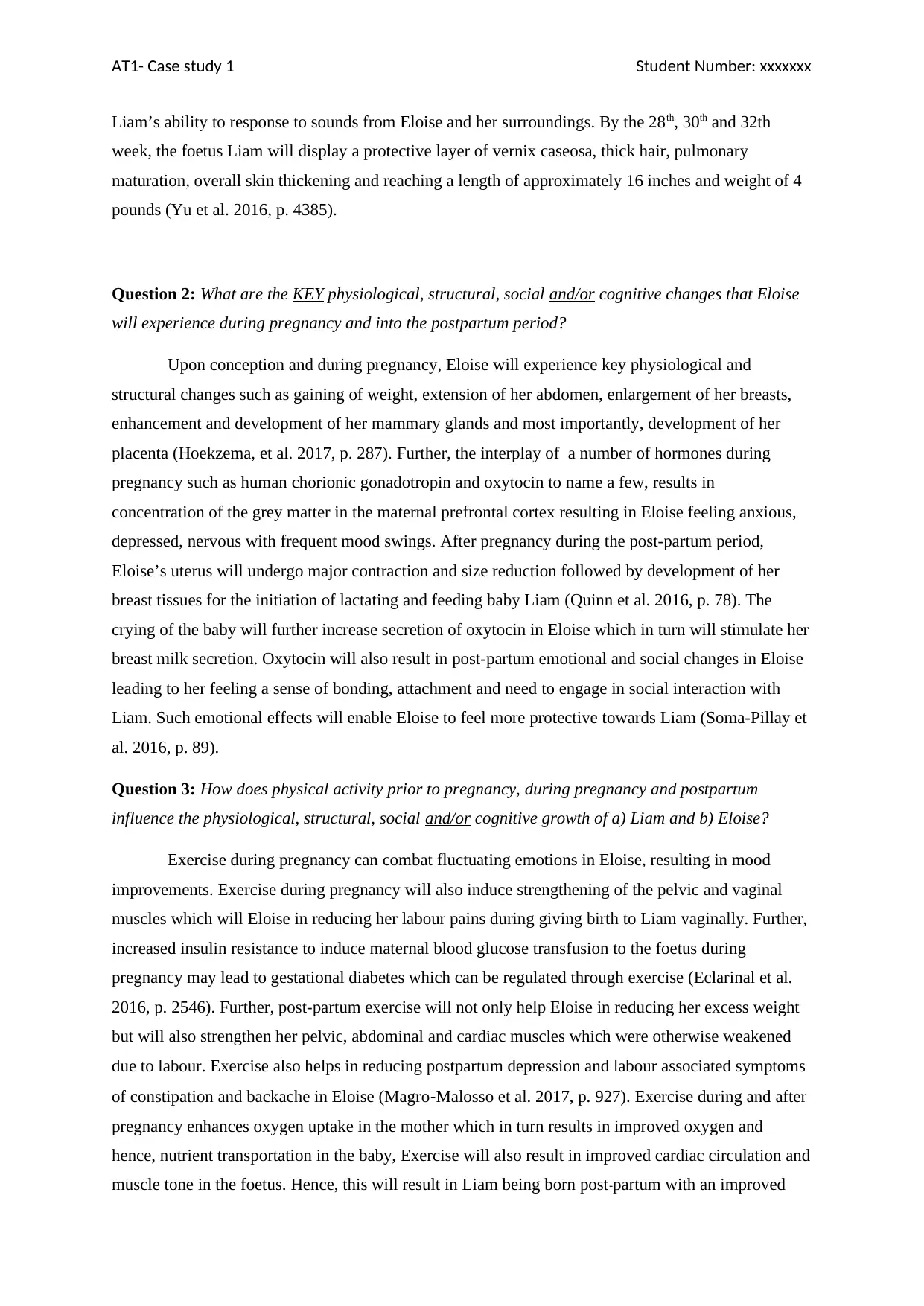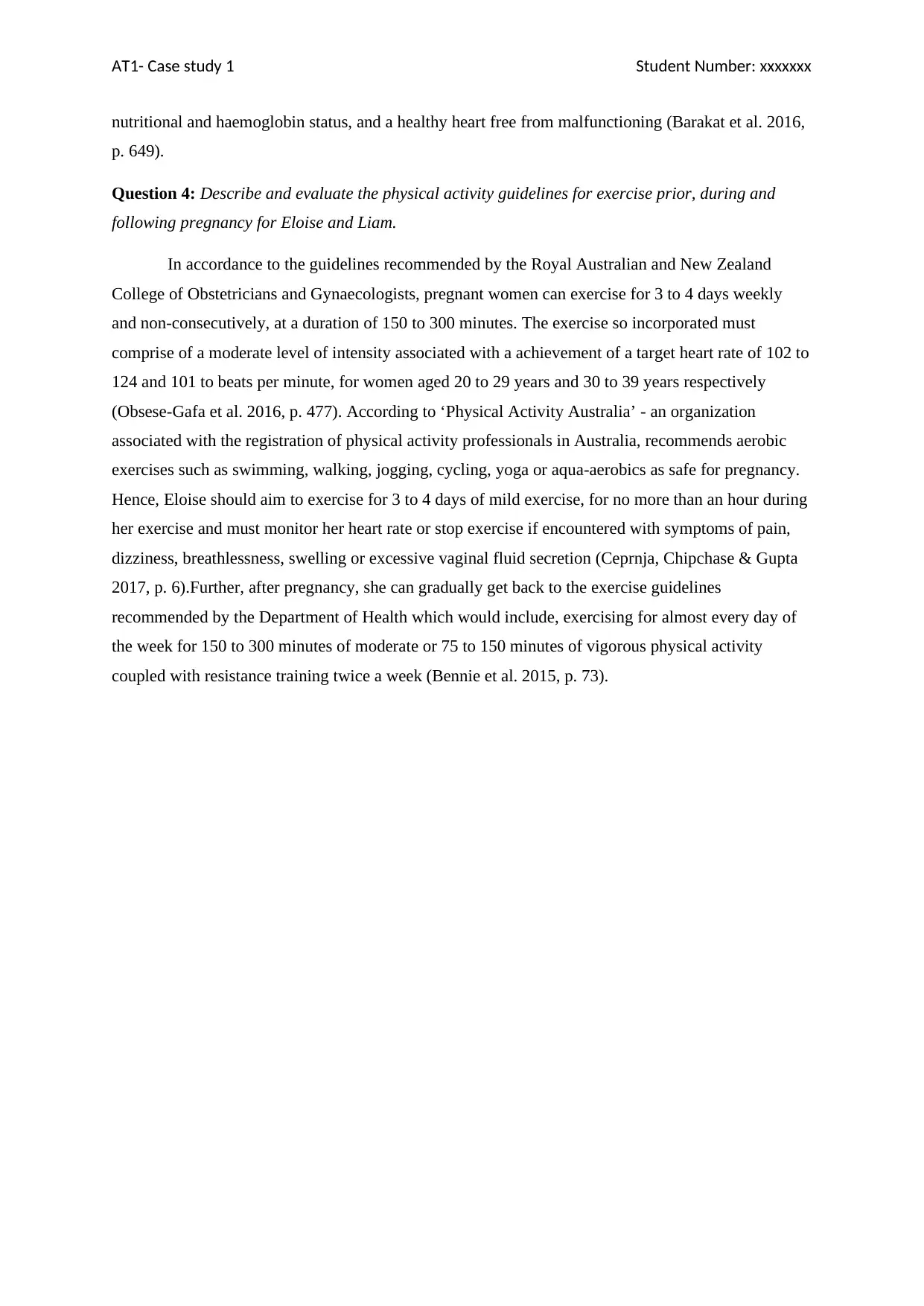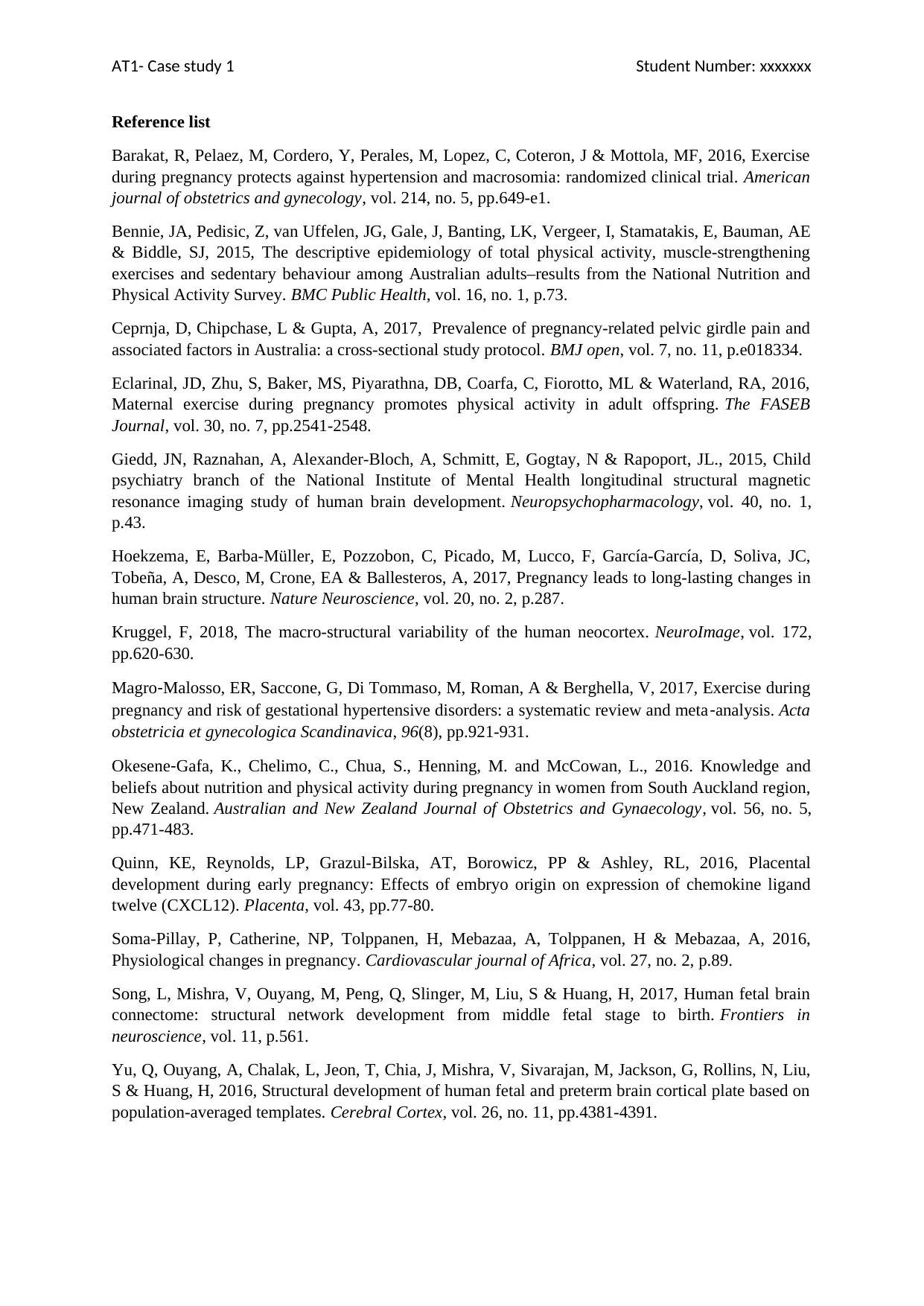HSE113 Case Study: Pregnancy, Exercise & Postpartum Analysis
VerifiedAdded on 2023/04/11
|4
|1662
|399
Case Study
AI Summary
This case study examines the physiological, structural, social, and cognitive changes experienced by Eloise during pregnancy and postpartum, as well as the developmental stages of the fetus, Liam, from conception to 32 weeks. It explores the impact of physical activity before, during, and after pregnancy on both mother and child, highlighting the benefits of exercise in managing gestational diabetes, improving maternal mood, and enhancing fetal development. The study also evaluates the physical activity guidelines recommended by the Royal Australian and New Zealand College of Obstetricians and Gynaecologists and Physical Activity Australia, emphasizing the importance of moderate-intensity exercise and monitoring for potential symptoms. The analysis includes a detailed reference list supporting the findings and recommendations. Desklib provides access to similar solved assignments and study resources for students.

AT1- Case study 1 Student Number: xxxxxxx
Human Growth and Development
Personal information
Student Name:
Student Number:
Seminar group (day/time/tutor name):
Campus:
Date of completion:
Responses to the questions AT1 case study 1 – Eloise and Liam
Question 1: What are the KEY physiological and structural changes which will occur for the foetus
Liam from conception to his current development stage?
Upon conception, the fertilised ovum for the foetus Liam will undergo extensive cell division
will travel to the uterus within the next 3 to 4 days and will proceed to undergo implantation in the
lining of the uterus during the first and second weeks commencing ovulation and fertilization. During
the 3rd and 4th week of gestational age after the conception of the foetus Liam, the heart of the foetus
will begin to undergo formation, which further initiates blood circulation. The 6th week will witness
the adequately developing its head and upper body components coupled with the proliferation of limb
buds. The premature tubular heart of the foetus will begin beating followed by proliferation of its
neural tube (Giedd et al. 2015, p. 43). By the 8th week, the foetus Liam will develop a heart which is
has four chambers, proliferate fingers and initiate nerve impulse transmission from the brain and
spinal cord developing from the neural tube. The foetus at 10 weeks will display distinctive limbs,
bone cell formation in replacement of cartilage, formation of eyelids and increased head size. At 12
weeks, the foetus will demonstrate fused eyelids, developing fingernails, formation of almost all
major body organ systems and minor, negligible detection of motor movements (Kruggel 2018, p.
625). The foetus at 14 weeks is able to open its mouth and swallow and blood formation is
demonstrated by its bone marrow. It will now be possible to determine the gender of the foetus at 16
weeks. It will demonstrate an erect head, developing legs and ‘lanugo’ or fine hair growth. By the 18th
week, the facial characteristics of Liam will be prominent and he will show response to sound (Song
et al. 2017, p. 561). The 20th week will demonstrate sebaceous gland formation and Liam’s mother
Eloise may be able to feel him kicking and moving. Liam may show grasping and sucking abilities
through thumb sucking if observed from ultrasound. At 22 weeks, Liam will have developed toenails,
complete lower limb formation and thickening of his lanugo. At 24 weeks, the foetus will demonstrate
weight gain, a length of 12 inches and approximate weight of 2 pounds. The 26th will demonstrate
Human Growth and Development
Personal information
Student Name:
Student Number:
Seminar group (day/time/tutor name):
Campus:
Date of completion:
Responses to the questions AT1 case study 1 – Eloise and Liam
Question 1: What are the KEY physiological and structural changes which will occur for the foetus
Liam from conception to his current development stage?
Upon conception, the fertilised ovum for the foetus Liam will undergo extensive cell division
will travel to the uterus within the next 3 to 4 days and will proceed to undergo implantation in the
lining of the uterus during the first and second weeks commencing ovulation and fertilization. During
the 3rd and 4th week of gestational age after the conception of the foetus Liam, the heart of the foetus
will begin to undergo formation, which further initiates blood circulation. The 6th week will witness
the adequately developing its head and upper body components coupled with the proliferation of limb
buds. The premature tubular heart of the foetus will begin beating followed by proliferation of its
neural tube (Giedd et al. 2015, p. 43). By the 8th week, the foetus Liam will develop a heart which is
has four chambers, proliferate fingers and initiate nerve impulse transmission from the brain and
spinal cord developing from the neural tube. The foetus at 10 weeks will display distinctive limbs,
bone cell formation in replacement of cartilage, formation of eyelids and increased head size. At 12
weeks, the foetus will demonstrate fused eyelids, developing fingernails, formation of almost all
major body organ systems and minor, negligible detection of motor movements (Kruggel 2018, p.
625). The foetus at 14 weeks is able to open its mouth and swallow and blood formation is
demonstrated by its bone marrow. It will now be possible to determine the gender of the foetus at 16
weeks. It will demonstrate an erect head, developing legs and ‘lanugo’ or fine hair growth. By the 18th
week, the facial characteristics of Liam will be prominent and he will show response to sound (Song
et al. 2017, p. 561). The 20th week will demonstrate sebaceous gland formation and Liam’s mother
Eloise may be able to feel him kicking and moving. Liam may show grasping and sucking abilities
through thumb sucking if observed from ultrasound. At 22 weeks, Liam will have developed toenails,
complete lower limb formation and thickening of his lanugo. At 24 weeks, the foetus will demonstrate
weight gain, a length of 12 inches and approximate weight of 2 pounds. The 26th will demonstrate
Paraphrase This Document
Need a fresh take? Get an instant paraphrase of this document with our AI Paraphraser

AT1- Case study 1 Student Number: xxxxxxx
Liam’s ability to response to sounds from Eloise and her surroundings. By the 28th, 30th and 32th
week, the foetus Liam will display a protective layer of vernix caseosa, thick hair, pulmonary
maturation, overall skin thickening and reaching a length of approximately 16 inches and weight of 4
pounds (Yu et al. 2016, p. 4385).
Question 2: What are the KEY physiological, structural, social and/or cognitive changes that Eloise
will experience during pregnancy and into the postpartum period?
Upon conception and during pregnancy, Eloise will experience key physiological and
structural changes such as gaining of weight, extension of her abdomen, enlargement of her breasts,
enhancement and development of her mammary glands and most importantly, development of her
placenta (Hoekzema, et al. 2017, p. 287). Further, the interplay of a number of hormones during
pregnancy such as human chorionic gonadotropin and oxytocin to name a few, results in
concentration of the grey matter in the maternal prefrontal cortex resulting in Eloise feeling anxious,
depressed, nervous with frequent mood swings. After pregnancy during the post-partum period,
Eloise’s uterus will undergo major contraction and size reduction followed by development of her
breast tissues for the initiation of lactating and feeding baby Liam (Quinn et al. 2016, p. 78). The
crying of the baby will further increase secretion of oxytocin in Eloise which in turn will stimulate her
breast milk secretion. Oxytocin will also result in post-partum emotional and social changes in Eloise
leading to her feeling a sense of bonding, attachment and need to engage in social interaction with
Liam. Such emotional effects will enable Eloise to feel more protective towards Liam (Soma-Pillay et
al. 2016, p. 89).
Question 3: How does physical activity prior to pregnancy, during pregnancy and postpartum
influence the physiological, structural, social and/or cognitive growth of a) Liam and b) Eloise?
Exercise during pregnancy can combat fluctuating emotions in Eloise, resulting in mood
improvements. Exercise during pregnancy will also induce strengthening of the pelvic and vaginal
muscles which will Eloise in reducing her labour pains during giving birth to Liam vaginally. Further,
increased insulin resistance to induce maternal blood glucose transfusion to the foetus during
pregnancy may lead to gestational diabetes which can be regulated through exercise (Eclarinal et al.
2016, p. 2546). Further, post-partum exercise will not only help Eloise in reducing her excess weight
but will also strengthen her pelvic, abdominal and cardiac muscles which were otherwise weakened
due to labour. Exercise also helps in reducing postpartum depression and labour associated symptoms
of constipation and backache in Eloise (Magro‐Malosso et al. 2017, p. 927). Exercise during and after
pregnancy enhances oxygen uptake in the mother which in turn results in improved oxygen and
hence, nutrient transportation in the baby, Exercise will also result in improved cardiac circulation and
muscle tone in the foetus. Hence, this will result in Liam being born post-partum with an improved
Liam’s ability to response to sounds from Eloise and her surroundings. By the 28th, 30th and 32th
week, the foetus Liam will display a protective layer of vernix caseosa, thick hair, pulmonary
maturation, overall skin thickening and reaching a length of approximately 16 inches and weight of 4
pounds (Yu et al. 2016, p. 4385).
Question 2: What are the KEY physiological, structural, social and/or cognitive changes that Eloise
will experience during pregnancy and into the postpartum period?
Upon conception and during pregnancy, Eloise will experience key physiological and
structural changes such as gaining of weight, extension of her abdomen, enlargement of her breasts,
enhancement and development of her mammary glands and most importantly, development of her
placenta (Hoekzema, et al. 2017, p. 287). Further, the interplay of a number of hormones during
pregnancy such as human chorionic gonadotropin and oxytocin to name a few, results in
concentration of the grey matter in the maternal prefrontal cortex resulting in Eloise feeling anxious,
depressed, nervous with frequent mood swings. After pregnancy during the post-partum period,
Eloise’s uterus will undergo major contraction and size reduction followed by development of her
breast tissues for the initiation of lactating and feeding baby Liam (Quinn et al. 2016, p. 78). The
crying of the baby will further increase secretion of oxytocin in Eloise which in turn will stimulate her
breast milk secretion. Oxytocin will also result in post-partum emotional and social changes in Eloise
leading to her feeling a sense of bonding, attachment and need to engage in social interaction with
Liam. Such emotional effects will enable Eloise to feel more protective towards Liam (Soma-Pillay et
al. 2016, p. 89).
Question 3: How does physical activity prior to pregnancy, during pregnancy and postpartum
influence the physiological, structural, social and/or cognitive growth of a) Liam and b) Eloise?
Exercise during pregnancy can combat fluctuating emotions in Eloise, resulting in mood
improvements. Exercise during pregnancy will also induce strengthening of the pelvic and vaginal
muscles which will Eloise in reducing her labour pains during giving birth to Liam vaginally. Further,
increased insulin resistance to induce maternal blood glucose transfusion to the foetus during
pregnancy may lead to gestational diabetes which can be regulated through exercise (Eclarinal et al.
2016, p. 2546). Further, post-partum exercise will not only help Eloise in reducing her excess weight
but will also strengthen her pelvic, abdominal and cardiac muscles which were otherwise weakened
due to labour. Exercise also helps in reducing postpartum depression and labour associated symptoms
of constipation and backache in Eloise (Magro‐Malosso et al. 2017, p. 927). Exercise during and after
pregnancy enhances oxygen uptake in the mother which in turn results in improved oxygen and
hence, nutrient transportation in the baby, Exercise will also result in improved cardiac circulation and
muscle tone in the foetus. Hence, this will result in Liam being born post-partum with an improved

AT1- Case study 1 Student Number: xxxxxxx
nutritional and haemoglobin status, and a healthy heart free from malfunctioning (Barakat et al. 2016,
p. 649).
Question 4: Describe and evaluate the physical activity guidelines for exercise prior, during and
following pregnancy for Eloise and Liam.
In accordance to the guidelines recommended by the Royal Australian and New Zealand
College of Obstetricians and Gynaecologists, pregnant women can exercise for 3 to 4 days weekly
and non-consecutively, at a duration of 150 to 300 minutes. The exercise so incorporated must
comprise of a moderate level of intensity associated with a achievement of a target heart rate of 102 to
124 and 101 to beats per minute, for women aged 20 to 29 years and 30 to 39 years respectively
(Obsese-Gafa et al. 2016, p. 477). According to ‘Physical Activity Australia’ - an organization
associated with the registration of physical activity professionals in Australia, recommends aerobic
exercises such as swimming, walking, jogging, cycling, yoga or aqua-aerobics as safe for pregnancy.
Hence, Eloise should aim to exercise for 3 to 4 days of mild exercise, for no more than an hour during
her exercise and must monitor her heart rate or stop exercise if encountered with symptoms of pain,
dizziness, breathlessness, swelling or excessive vaginal fluid secretion (Ceprnja, Chipchase & Gupta
2017, p. 6).Further, after pregnancy, she can gradually get back to the exercise guidelines
recommended by the Department of Health which would include, exercising for almost every day of
the week for 150 to 300 minutes of moderate or 75 to 150 minutes of vigorous physical activity
coupled with resistance training twice a week (Bennie et al. 2015, p. 73).
nutritional and haemoglobin status, and a healthy heart free from malfunctioning (Barakat et al. 2016,
p. 649).
Question 4: Describe and evaluate the physical activity guidelines for exercise prior, during and
following pregnancy for Eloise and Liam.
In accordance to the guidelines recommended by the Royal Australian and New Zealand
College of Obstetricians and Gynaecologists, pregnant women can exercise for 3 to 4 days weekly
and non-consecutively, at a duration of 150 to 300 minutes. The exercise so incorporated must
comprise of a moderate level of intensity associated with a achievement of a target heart rate of 102 to
124 and 101 to beats per minute, for women aged 20 to 29 years and 30 to 39 years respectively
(Obsese-Gafa et al. 2016, p. 477). According to ‘Physical Activity Australia’ - an organization
associated with the registration of physical activity professionals in Australia, recommends aerobic
exercises such as swimming, walking, jogging, cycling, yoga or aqua-aerobics as safe for pregnancy.
Hence, Eloise should aim to exercise for 3 to 4 days of mild exercise, for no more than an hour during
her exercise and must monitor her heart rate or stop exercise if encountered with symptoms of pain,
dizziness, breathlessness, swelling or excessive vaginal fluid secretion (Ceprnja, Chipchase & Gupta
2017, p. 6).Further, after pregnancy, she can gradually get back to the exercise guidelines
recommended by the Department of Health which would include, exercising for almost every day of
the week for 150 to 300 minutes of moderate or 75 to 150 minutes of vigorous physical activity
coupled with resistance training twice a week (Bennie et al. 2015, p. 73).
⊘ This is a preview!⊘
Do you want full access?
Subscribe today to unlock all pages.

Trusted by 1+ million students worldwide

AT1- Case study 1 Student Number: xxxxxxx
Reference list
Barakat, R, Pelaez, M, Cordero, Y, Perales, M, Lopez, C, Coteron, J & Mottola, MF, 2016, Exercise
during pregnancy protects against hypertension and macrosomia: randomized clinical trial. American
journal of obstetrics and gynecology, vol. 214, no. 5, pp.649-e1.
Bennie, JA, Pedisic, Z, van Uffelen, JG, Gale, J, Banting, LK, Vergeer, I, Stamatakis, E, Bauman, AE
& Biddle, SJ, 2015, The descriptive epidemiology of total physical activity, muscle-strengthening
exercises and sedentary behaviour among Australian adults–results from the National Nutrition and
Physical Activity Survey. BMC Public Health, vol. 16, no. 1, p.73.
Ceprnja, D, Chipchase, L & Gupta, A, 2017, Prevalence of pregnancy-related pelvic girdle pain and
associated factors in Australia: a cross-sectional study protocol. BMJ open, vol. 7, no. 11, p.e018334.
Eclarinal, JD, Zhu, S, Baker, MS, Piyarathna, DB, Coarfa, C, Fiorotto, ML & Waterland, RA, 2016,
Maternal exercise during pregnancy promotes physical activity in adult offspring. The FASEB
Journal, vol. 30, no. 7, pp.2541-2548.
Giedd, JN, Raznahan, A, Alexander-Bloch, A, Schmitt, E, Gogtay, N & Rapoport, JL., 2015, Child
psychiatry branch of the National Institute of Mental Health longitudinal structural magnetic
resonance imaging study of human brain development. Neuropsychopharmacology, vol. 40, no. 1,
p.43.
Hoekzema, E, Barba-Müller, E, Pozzobon, C, Picado, M, Lucco, F, García-García, D, Soliva, JC,
Tobeña, A, Desco, M, Crone, EA & Ballesteros, A, 2017, Pregnancy leads to long-lasting changes in
human brain structure. Nature Neuroscience, vol. 20, no. 2, p.287.
Kruggel, F, 2018, The macro-structural variability of the human neocortex. NeuroImage, vol. 172,
pp.620-630.
Magro‐Malosso, ER, Saccone, G, Di Tommaso, M, Roman, A & Berghella, V, 2017, Exercise during
pregnancy and risk of gestational hypertensive disorders: a systematic review and meta‐analysis. Acta
obstetricia et gynecologica Scandinavica, 96(8), pp.921-931.
Okesene‐Gafa, K., Chelimo, C., Chua, S., Henning, M. and McCowan, L., 2016. Knowledge and
beliefs about nutrition and physical activity during pregnancy in women from South Auckland region,
New Zealand. Australian and New Zealand Journal of Obstetrics and Gynaecology, vol. 56, no. 5,
pp.471-483.
Quinn, KE, Reynolds, LP, Grazul-Bilska, AT, Borowicz, PP & Ashley, RL, 2016, Placental
development during early pregnancy: Effects of embryo origin on expression of chemokine ligand
twelve (CXCL12). Placenta, vol. 43, pp.77-80.
Soma-Pillay, P, Catherine, NP, Tolppanen, H, Mebazaa, A, Tolppanen, H & Mebazaa, A, 2016,
Physiological changes in pregnancy. Cardiovascular journal of Africa, vol. 27, no. 2, p.89.
Song, L, Mishra, V, Ouyang, M, Peng, Q, Slinger, M, Liu, S & Huang, H, 2017, Human fetal brain
connectome: structural network development from middle fetal stage to birth. Frontiers in
neuroscience, vol. 11, p.561.
Yu, Q, Ouyang, A, Chalak, L, Jeon, T, Chia, J, Mishra, V, Sivarajan, M, Jackson, G, Rollins, N, Liu,
S & Huang, H, 2016, Structural development of human fetal and preterm brain cortical plate based on
population-averaged templates. Cerebral Cortex, vol. 26, no. 11, pp.4381-4391.
Reference list
Barakat, R, Pelaez, M, Cordero, Y, Perales, M, Lopez, C, Coteron, J & Mottola, MF, 2016, Exercise
during pregnancy protects against hypertension and macrosomia: randomized clinical trial. American
journal of obstetrics and gynecology, vol. 214, no. 5, pp.649-e1.
Bennie, JA, Pedisic, Z, van Uffelen, JG, Gale, J, Banting, LK, Vergeer, I, Stamatakis, E, Bauman, AE
& Biddle, SJ, 2015, The descriptive epidemiology of total physical activity, muscle-strengthening
exercises and sedentary behaviour among Australian adults–results from the National Nutrition and
Physical Activity Survey. BMC Public Health, vol. 16, no. 1, p.73.
Ceprnja, D, Chipchase, L & Gupta, A, 2017, Prevalence of pregnancy-related pelvic girdle pain and
associated factors in Australia: a cross-sectional study protocol. BMJ open, vol. 7, no. 11, p.e018334.
Eclarinal, JD, Zhu, S, Baker, MS, Piyarathna, DB, Coarfa, C, Fiorotto, ML & Waterland, RA, 2016,
Maternal exercise during pregnancy promotes physical activity in adult offspring. The FASEB
Journal, vol. 30, no. 7, pp.2541-2548.
Giedd, JN, Raznahan, A, Alexander-Bloch, A, Schmitt, E, Gogtay, N & Rapoport, JL., 2015, Child
psychiatry branch of the National Institute of Mental Health longitudinal structural magnetic
resonance imaging study of human brain development. Neuropsychopharmacology, vol. 40, no. 1,
p.43.
Hoekzema, E, Barba-Müller, E, Pozzobon, C, Picado, M, Lucco, F, García-García, D, Soliva, JC,
Tobeña, A, Desco, M, Crone, EA & Ballesteros, A, 2017, Pregnancy leads to long-lasting changes in
human brain structure. Nature Neuroscience, vol. 20, no. 2, p.287.
Kruggel, F, 2018, The macro-structural variability of the human neocortex. NeuroImage, vol. 172,
pp.620-630.
Magro‐Malosso, ER, Saccone, G, Di Tommaso, M, Roman, A & Berghella, V, 2017, Exercise during
pregnancy and risk of gestational hypertensive disorders: a systematic review and meta‐analysis. Acta
obstetricia et gynecologica Scandinavica, 96(8), pp.921-931.
Okesene‐Gafa, K., Chelimo, C., Chua, S., Henning, M. and McCowan, L., 2016. Knowledge and
beliefs about nutrition and physical activity during pregnancy in women from South Auckland region,
New Zealand. Australian and New Zealand Journal of Obstetrics and Gynaecology, vol. 56, no. 5,
pp.471-483.
Quinn, KE, Reynolds, LP, Grazul-Bilska, AT, Borowicz, PP & Ashley, RL, 2016, Placental
development during early pregnancy: Effects of embryo origin on expression of chemokine ligand
twelve (CXCL12). Placenta, vol. 43, pp.77-80.
Soma-Pillay, P, Catherine, NP, Tolppanen, H, Mebazaa, A, Tolppanen, H & Mebazaa, A, 2016,
Physiological changes in pregnancy. Cardiovascular journal of Africa, vol. 27, no. 2, p.89.
Song, L, Mishra, V, Ouyang, M, Peng, Q, Slinger, M, Liu, S & Huang, H, 2017, Human fetal brain
connectome: structural network development from middle fetal stage to birth. Frontiers in
neuroscience, vol. 11, p.561.
Yu, Q, Ouyang, A, Chalak, L, Jeon, T, Chia, J, Mishra, V, Sivarajan, M, Jackson, G, Rollins, N, Liu,
S & Huang, H, 2016, Structural development of human fetal and preterm brain cortical plate based on
population-averaged templates. Cerebral Cortex, vol. 26, no. 11, pp.4381-4391.
1 out of 4
Your All-in-One AI-Powered Toolkit for Academic Success.
+13062052269
info@desklib.com
Available 24*7 on WhatsApp / Email
![[object Object]](/_next/static/media/star-bottom.7253800d.svg)
Unlock your academic potential
Copyright © 2020–2025 A2Z Services. All Rights Reserved. Developed and managed by ZUCOL.